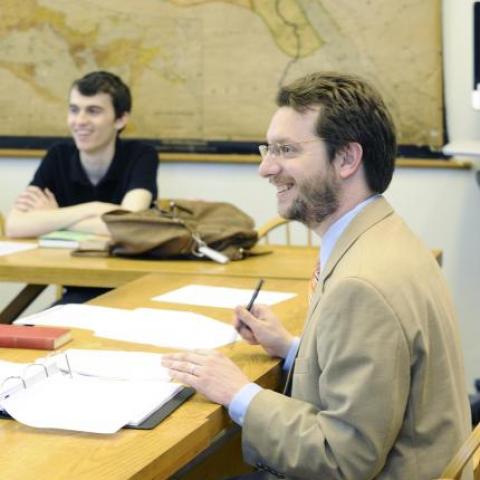Come by Hall 109
Education
B.A., Wesleyan University
Ph.D., Brown University
Biography
You could say that I am a bit of an "accidental Classicist." I was always a voracious reader. I hoped to be a teacher ever since my seventh-grade social studies teacher let me teach an occasional class. But it was only when I took a college course on Latin literature in translation, that I discovered Latin and Greek and was bewitched by Classical literature and culture. Classics has been called the first interdisciplinary major, and it is exactly this range and diversity of inquiry that I find so appealing. Now I spend my days discussing great works of art, thorny questions of the human condition, and fascinating moments of our shared history—not to mention helping students learn the languages that will allow them to fully appreciate both the art and cultures of antiquity. Bonam Vitam!
Research
My scholarship focuses on the twilight of classical culture, the period now known as "Late Antiquity." One of the first things I learned about Rome was that it "fell" and it is this period—when massive political, ethnic, and religious change transformed Roman society that continues to draw my curiosity. In particular, I'm interested in the adaptive strategies taken by authors when they must contend with a frightening accumulation of tradition, a cultural moment that has many similarities with our own age. The engagement of late antique authors with their artistic predecessors allows me to dabble in the full range of Classical antiquity. And since this period was also when much of Classical culture was packaged for transmission through the medieval period to us, it also serves as an ideal jumping-off-point for my interest in the Classical Tradition and the continuing influence of Classical culture. Digital humanities also forms a significant node for my research, including digital commentaries resources to support effective reading of Latin and Greek (bridge.haverford.edu), as well as the analysis of the readability of historical texts.
Current Projects
- Vandal Epigram: a Verse Translation with Introduction and Notes).
- Vocabulary Instruction and Acquisition via Lemmatization
- Further Studies in Latin Vocabulary and the Readability of Latin Texts
- A Commentary on Martial, Epigrams Book 10
- The Poetics of Claudian’s Carmina Minora (monograph, under contract with Brill)
- Claudian Reads Statius, for the Wiley-Blackwell Companion to Flavian Epic
- After Cato Left the Theater: Performative Masculinity in Catullus 56
- Drunken Poets and Fallen Philosophers: Gout as a Metaphoric Disease in Antiquity
- The Bridge: Customizable Greek & Latin Vocabularies (bridge.haverford.edu)
- Concordance Liberation Project
- Commentary Sandbox (a Wordpress plugin to create DCC-style commentaries; iris.haverford.edu/sandbox/)
Select Recent Publications
- The Crisis of Catiline: Rome, 63 BCE (University of North Carolina Press).
- The Poetry of Ennodius (an annotated translation of the poetry by the sixth-century bishop and saint)
- The Jeweled Style in Later Epigram in The Jeweled Style Revisited
- “Santé, Maladie, Médecine” in Dictionnaire des Images du Poetique (forthcoming).
- Latin Vocabulary Knowledge and the Readability of Latin Texts: A Preliminary Study, co-authored with J. Gruber-Miller in Festschrift for Jacqui Carlon (forthcoming, New England Classical Journal 49.1).
- Bad Medicine: the Reception of Martial in the Epigrams of John Owen and Ludvig Holberg (forthcoming, Éditions Ausonius)
- “Ennodius” in the Brill Encyclopedia of Early Christianity (Brill, 2019).
- Obscenity in the Ancient Greek and Roman Epigram, in Blackwell-Wiley Companion to Ancient Epigram (Wiley-Blackwell, 2019).
- Epigrams, Occasional Poetry, and Poetic Games, in Blackwell-Wiley Companion to Late Antique Literature (Wiley-Blackwell, 2018).
- Translation and the Poetics of Replication in the Late Antique Latin Epigram, in Classics Renewed. Reception and Innovation in the Latin Poetry of Late Antiquity (Winter Verlag, 2016).
- Life of Hannibal, Cornelius Nepos (Open Books Publishers, 2015).
- Gout, Beasts, and Other Metaphorical Punishments in AP 11.226–31 (Mnemosyne 68 (2015): 721–739).
- Coniuratio! Ethopoeia and Reacting to the Past in the Latin Classroom (and Beyond), (Classical Journal 109.3, Feb/Mar 2014).
- Infusing Theory into the Undergraduate Classics Curriculum: Examples from Haverford’s “Senior Seminar” and “History of Literary Theory” (with Robert Germany and Deborah Roberts, forthcoming, Classical World, 2014)
- Bad Scorpion: Cacemphaton and Readership in Martial's Ligurinus Cycle (Classical World, 2013)
- Life of Hannibal by Cornelius Nepos: Introduction, Text, and Commentary (Dickinson College Commentaries, Summer 2013).
- Animal Play: Bilingual Onomastics and the Arrangement of Statius Silvae 2, (Studies in Latin Literature and Roman History 16, 2012).
- Ἱερὸς Argus: Bilingual Wordplay in Statius Silvae 5.4.12 (Mnemosyne 64 (2011): 471–80).
- Meditations on a Taut but Happy Class, Teaching and Learning Together in Higher Education 2 (2011).
